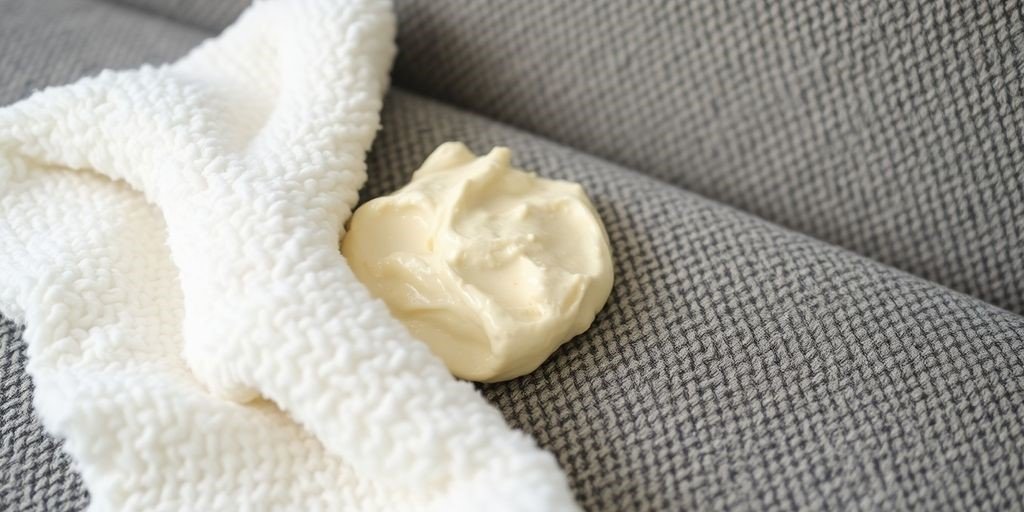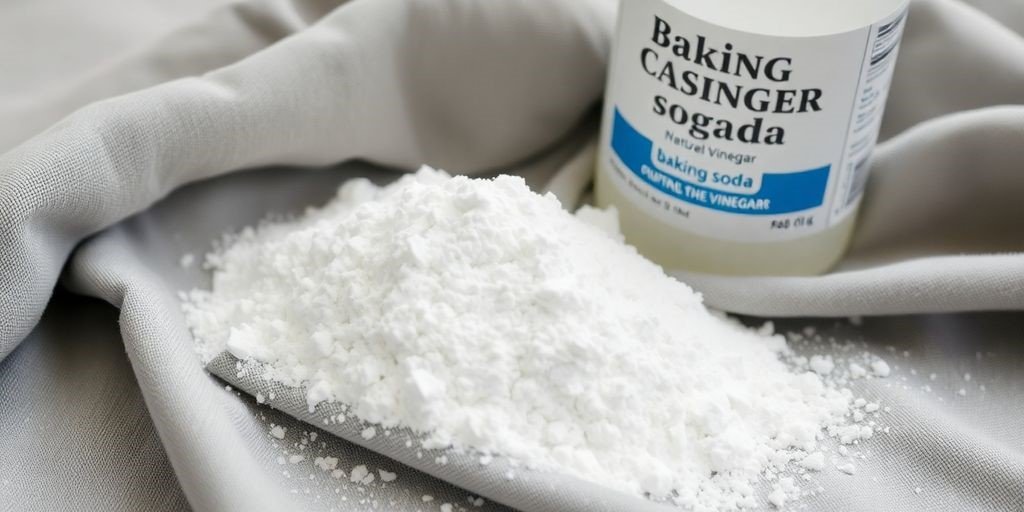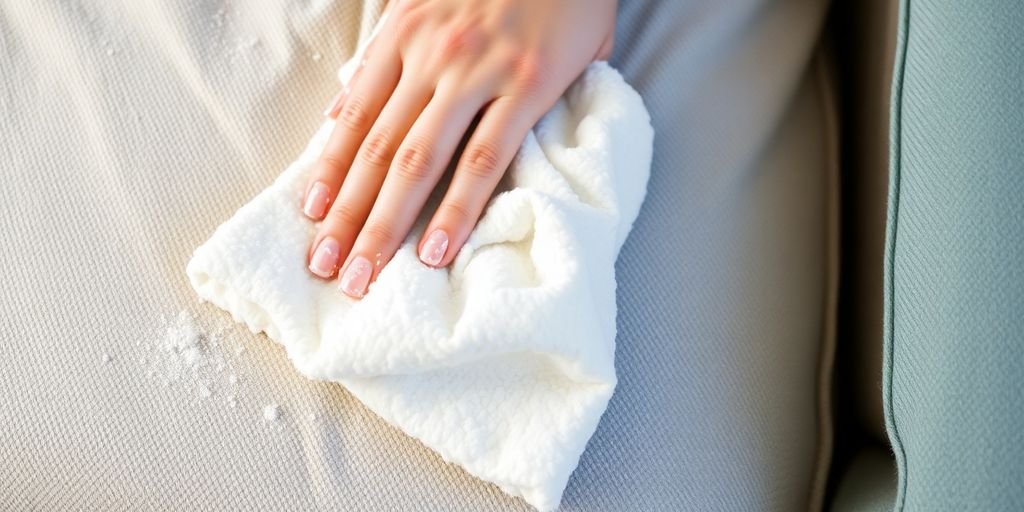So, your couch or favorite chair is looking a little worse for wear? Maybe there are some mystery spots, or it just smells a bit… lived-in. Before you call in the pros or buy a whole new piece of furniture, consider this: you probably have the secret weapon right in your kitchen. Baking soda and vinegar aren’t just for baking or cleaning the kitchen sink.
They’re surprisingly effective for tackling upholstery, too. We’re talking about getting your furniture looking and smelling fresh again, using stuff you already have. If you’re in the Denver area and looking for a natural way to spruce up your upholstery, this guide is for you.
Key Takeaways
- Baking soda is great for absorbing odors and acting as a gentle scrubber on upholstery.
- White vinegar is a natural cleaner that helps break down stains and neutralize smells.
- Always test your cleaning solution on a hidden spot first to avoid discoloration.
- Vacuuming up loose debris before wet cleaning is an important first step.
- Blotting stains rather than rubbing helps prevent damage and spreading the mess.
Why Use Baking Soda and Vinegar for Upholstery Cleaning?
When you’re looking for simple, effective ways to keep your furniture looking its best, you might be surprised at what you can find right in your kitchen pantry. Baking soda and vinegar aren’t just for baking or cleaning the kitchen sink; they’re surprisingly capable when it comes to upholstery.
Think about it: baking soda is a fantastic natural deodorizer, soaking up those lingering smells that fabric tends to hold onto. It’s also a mild abrasive, which means it can help lift away light dirt and grime without being harsh on your upholstery fibers. Then there’s vinegar.
This common household staple is a powerhouse when it comes to tackling stains. Its acidic nature helps break down many types of common household spills and spots, making them easier to lift away. Together, these two ingredients offer a budget-friendly and less chemically-intensive approach to refreshing your furniture. Many people are looking for effective [Denver home cleaning hacks], and this is one of them.
Understanding the Cleaning Power of Baking Soda and Vinegar

So, why do these two common household items work so well together on upholstery? It’s all about their unique properties.
Baking Soda: The Natural Deodorizer and Mild Abrasive
Baking soda, or sodium bicarbonate, is a real multitasker. It’s a fantastic natural deodorizer because it doesn’t just mask smells; it neutralizes them by absorbing odor molecules. Think of it like a tiny sponge for bad smells. Plus, its slightly gritty texture makes it a gentle abrasive.
This means it can help lift away dirt and grime without being harsh enough to damage most fabrics. It’s great for getting out those lingering pet odors or that faint musty smell that can settle into furniture over time. It’s also pretty effective at absorbing excess moisture, which can help prevent mildew.
Vinegar: The Acidic Powerhouse for Stain Removal
Vinegar, typically white distilled vinegar, in cleaning, is acidic. This acidity is what makes it a champion at breaking down various types of stains, especially those caused by things like coffee, tea, or even some food spills.
The acid works to dissolve the stain molecules, making them easier to lift away from the fabric fibers. It also has some natural disinfectant properties, which is a nice bonus. However, because it’s acidic, you always want to be careful and test it first, especially on delicate or brightly colored fabrics.
It can sometimes cause discoloration if used too strongly or left on too long. For really tough stains, a paste made from baking soda and a little vinegar can create a fizzing action that helps lift the mess.
Here’s a quick look at what makes them effective:
- Deodorizing: Baking soda absorbs and neutralizes odors.
- Stain Lifting: Vinegar’s acidity breaks down many common stains.
- Gentle Scrubbing: Baking soda provides mild abrasion to lift dirt.
- Disinfecting: Vinegar offers some natural sanitizing qualities.
Using these natural cleaners is a great way to keep your furniture looking good and smelling fresh without resorting to harsh chemicals. It’s a smart approach to upholstery cleaning that’s both effective and budget-friendly.
Prepping Your Upholstery for Cleaning

Before you start slathering baking soda and vinegar all over your couch, it’s smart to do a little prep work. This isn’t just about making the cleaning process smoother; it’s about protecting your furniture. Think of it as a quick check-up for your upholstery.
These simple steps can save you from potential headaches later on, especially if you’re trying out some new [DIY upholstery cleaner Denver] techniques.
Identify Your Upholstery Type
Not all fabrics are created equal, and what works for one might not work for another. You need to know what you’re dealing with. Check the manufacturer’s tag – it usually has a cleaning code. These codes are super important:
- W: Water-based cleaners are okay.
- S: Solvent-based cleaners only. No water!
- W/S: Either water-based or solvent-based cleaners can be used.
- X: Vacuum only. No liquids at all.
Spot Test in an Inconspicuous Area
This is probably the most critical step in any DIY cleaning project. You don’t want to discover that your homemade couch cleaner has turned your favorite armchair a weird color after you’ve cleaned the whole thing. Find a hidden spot – maybe the back of a cushion, under the skirt of the sofa, or on a seam allowance.
Step-by-Step Guide: Cleaning Upholstery with Baking Soda and Vinegar
Ready to tackle that sofa or armchair? Cleaning upholstery with baking soda and vinegar might sound a bit unusual, but it’s a surprisingly effective and natural way to refresh your furniture. It’s a great alternative if you’re trying to avoid harsh chemicals.
Let’s break down how to do it, step by step.
Step 1: Vacuuming Loose Debris
First things first, you need to get rid of any loose stuff sitting on your upholstery. Grab your vacuum cleaner and use the upholstery attachment.
Go over the entire piece – cushions, arms, back, everything. This gets rid of crumbs, pet hair, dust, and anything else that could turn into mud when you add moisture. It’s a simple step, but it makes a big difference in the final clean.
Step 2: Applying Baking Soda
Now, for the odor-absorbing magic. Sprinkle baking soda generously over the entire surface of your upholstery. Don’t be shy with it! Let it sit for at least 15-20 minutes, but honestly, leaving it for a few hours or even overnight is even better, especially if you’re dealing with lingering smells.
Step 3: Creating and Applying the Vinegar Solution
Time for the vinegar. Mix equal parts white vinegar and water in a spray bottle. So, if you use a cup of vinegar, add a cup of water. You can lightly mist this solution onto the upholstery. The goal isn’t to soak the fabric, just to lightly dampen it.
This vinegar solution helps break down stains and further neutralizes odors. For those in Denver looking to, this combination is your best bet.
Step 4: Blotting and Rinsing
Grab a clean microfiber cloth. Gently blot the areas where you applied the vinegar solution. You’re not scrubbing here; you’re just lifting the dirt and moisture. If you notice any residue from the baking soda or vinegar, use a slightly damp cloth (just water) to blot those areas.
This helps rinse away any remaining cleaning agents. It’s important to blot rather than rub to avoid damaging the fabric fibers.
Step 5: Drying and Final Vacuuming
Let your upholstery air dry completely. This might take a few hours, depending on how much moisture you used and your room’s humidity. Avoid sitting on it until it’s totally dry. Once it’s dry, give it another quick vacuum.
This will pick up any dried baking soda residue and help fluff up the fabric. You’ll be amazed at how much fresher and cleaner your furniture looks and smells. If you’re interested in cleaning carpet with baking soda in Denver, the principles are quite similar.
Tips for Tackling Specific Upholstery Stains
Sometimes, you need a little extra help beyond the basic baking soda and vinegar mix. Different types of stains respond best to specific treatments, so knowing what you’re dealing with can save you a lot of hassle.
It’s always a good idea to test any cleaning solution on a hidden spot first, just to make sure it doesn’t affect your upholstery’s color or texture. This is especially true when you’re trying out a new diy upholstery stain remover in Denver.
Coffee or Tea Stains
For those morning coffee spills or afternoon tea mishaps, act fast. Blot up as much of the liquid as you can with a clean cloth. Then, try a simple solution of warm water mixed with a tiny bit of mild dish soap.
Let it sit for a few minutes, then gently blot with a damp cloth to lift the stain. This method is pretty effective for the most common beverage stains.
Ink Stains
Ink can be tricky, but rubbing alcohol can be a lifesaver. Grab a cotton ball, dab it with rubbing alcohol, and gently blot the ink stain. Keep blotting with a clean part of the cloth until the ink starts to lift. Remember, blotting is key here, not rubbing, which can spread the ink.
Grease or Oil Stains
Grease and oil stains are best tackled with baking soda. Sprinkle a generous amount of baking soda directly onto the stain and let it sit for about 15 minutes. The baking soda will absorb the oil. After 15 minutes, vacuum up the baking soda.
You might need to follow up with a water-based upholstery cleaner for any remaining residue. This is a great example of using vinegar for upholstery stains in Denver.
Pet Stains
Pet accidents are never fun, but they happen. For these, you’ll want an enzymatic cleaner specifically made for upholstery. These cleaners are designed to break down the organic matter that causes stains and odors.
Always follow the product’s instructions carefully. Quick action is your best friend when dealing with pet messes to prevent them from setting in.
General Upholstery Cleaning Solution
For everyday spills and light dirt, a mixture of equal parts white vinegar and warm water, with a few drops of mild dish soap, works well.
Put this in a spray bottle and lightly mist the fabric. Then, gently wipe with a clean, damp cloth. This is a good all-around approach for regular upkeep and light cleaning.
Stubborn or Set-In Stains
Older stains can be tougher. A paste made from baking soda and water can help. Apply this thick paste directly to the stain and let it sit for 15 to 30 minutes. This gives the baking soda time to work on lifting the stain.
Afterward, gently wipe the area with a damp cloth and blot it dry. Sometimes, repeating the process or using a specialized upholstery stain removal product is necessary for really tough spots.
When to Call a Professional Upholstery Cleaner
While baking soda and vinegar are great for many everyday messes, sometimes you need to call in the pros. If you’ve got stubborn stains that just won’t budge, or if your upholstery is made of delicate material like silk or certain types of wool, it’s probably time to find a professional. Trying to tackle these yourself could end up making things worse, maybe even permanently damaging the fabric.
It’s also worth considering professional help if you’ve tried a few things and aren’t seeing the results you want. Sometimes, a professional cleaning service can make a big difference. If you’re in the market for someone who specializes in [natural upholstery cleaning Denver], they can often provide eco-friendly options too.
When DIY Isn’t Enough
- Deep-set Stains: For stains that have been around for a while or have soaked deep into the fabric, professional cleaning is often necessary. They have stronger, yet safe, cleaning agents.
- Delicate Fabrics: Materials like silk, velvet, or certain antique fabrics require specialized care that DIY methods might not provide.
- Large-Scale Cleaning: If you need to clean an entire sofa or multiple pieces of furniture, a professional service can handle it efficiently.
- Unknown Stains: If you don’t know what caused the stain, a professional can often identify and treat it more effectively.
Signs You Need a Professional
- Your DIY attempts have failed to remove the stain or odor.
- The fabric care tag indicates ‘S’ (solvent-based cleaning only) or ‘X’ (vacuum only).
- You notice discoloration or damage after attempting to clean it yourself.
- The furniture has significant wear and tear, and you want a thorough restoration.
For upholstery stains, it’s best to contact a professional cleaning service within two to three days. Professional truck-mounted water extraction machines are recommended for effective cleaning of carpets and upholstery. If you’re looking for [natural upholstery cleaner denver], many services offer these specialized treatments.
Is your couch or chair looking a little sad? If you notice stubborn spots, lingering smells, or just a general dingy appearance, it might be time to bring in the experts. Don’t let everyday messes ruin your favorite furniture. Visit our website to learn more about how we can refresh your home’s comfort!
Frequently Asked Questions
Why use baking soda and vinegar on upholstery?
Baking soda is great for making things smell fresh and can help with light spots. Vinegar is good at tackling tougher stains because it’s acidic. Together, they can clean and freshen up your furniture.
Should I test the cleaning solution first?
Always test your cleaning mix on a hidden spot first, like the back or underside of the furniture. This makes sure it won’t change the color or damage the fabric.
How do I make the baking soda and vinegar cleaner?
For general cleaning, mix equal parts white vinegar and water in a spray bottle. For tougher stains, make a paste using baking soda and a little water. Apply the paste, let it sit, then wipe it away.
How should I apply the cleaner to the upholstery?
After applying the cleaning solution, gently blot the area with a clean cloth. Don’t scrub too hard, as this can harm the fabric. Then, use a damp cloth to wipe away any leftover cleaner.
Can I use baking soda on all types of upholstery?
Baking soda is good for most fabrics, but be careful with delicate materials like silk or velvet, as it might cause damage. It can also dry out leather. When in doubt, always do a spot test.
Will baking soda and vinegar remove deep stains?
Baking soda is mainly for odors and light stains. Vinegar is better for tougher stains. If you have really stubborn spots or deep-set dirt, you might need a stronger cleaner or to call a professional.

